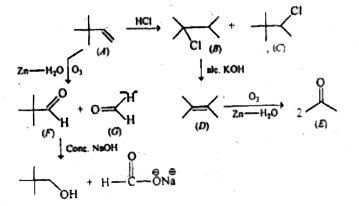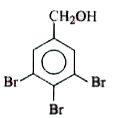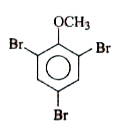Compound (A) is insoluble in aqueous and dissolves in aqueous NaOH and gives a characteristic colour with neutral . When treated with (A) forms compound (B) .
The most probable structure of compound A is :




The correct Answer is:B
To determine the most probable structure of compound (A) with the molecular formula C7H8O, we will analyze the given information step by step.
Step 1: Analyze the Solubility in NaHCO3 and NaOH
- Given: Compound (A) is insoluble in aqueous NaHCO3 and soluble in aqueous NaOH.
- Interpretation:
- Insolubility in NaHCO3 suggests that compound (A) does not contain a strong acidic group (like carboxylic acids) since such compounds typically react with NaHCO3.
- Solubility in NaOH indicates that compound (A) likely contains a weak acidic group, such as a phenolic -OH group.
Step 2: Reaction with FeCl3
- Given: Compound (A) gives a characteristic color with neutral FeCl3.
- Interpretation:
- The formation of a colored complex with FeCl3 suggests the presence of a phenolic -OH group or an alcoholic -OH group. This is a characteristic reaction of phenols.
Step 3: Reaction with Bromine
- Given: When treated with Br2, compound (A) forms compound (B) with the formula C7H5OBr3.
- Interpretation:
- The formation of a tribrominated product indicates that compound (A) likely has multiple reactive sites for bromination, which is typical for phenolic compounds.
Step 4: Evaluate the Options
Now, we will evaluate the given options based on the above interpretations.
1. Option A: Contains -OH and -CH3 in ortho position.
- Analysis: This compound can dissolve in NaOH and gives a color with FeCl3. However, it will not give a tribrominated product as required. Thus, this option is incorrect.
2. Option B: Contains -OH and -CH3 in meta position.
- Analysis: This compound satisfies all conditions: it is insoluble in NaHCO3, soluble in NaOH, gives a color with FeCl3, and can yield a tribrominated product. Thus, this option is correct.
3. Option C: Contains -OH and -CH3 in para position.
- Analysis: This compound also dissolves in NaOH and gives a color with FeCl3, but it will not yield a tribrominated product due to steric hindrance. Thus, this option is incorrect.
4. Option D: Contains no -OH group.
- Analysis: This compound does not meet any of the conditions (not soluble in NaHCO3 or NaOH, and does not give a color with FeCl3). Thus, this option is incorrect.
Conclusion
The most probable structure of compound (A) is represented by Option B, which is a meta-substituted phenol with a methyl group.
- Given: Compound (A) is insoluble in aqueous NaHCO3 and soluble in aqueous NaOH.
- Interpretation:
- Insolubility in NaHCO3 suggests that compound (A) does not contain a strong acidic group (like carboxylic acids) since such compounds typically react with NaHCO3.
- Solubility in NaOH indicates that compound (A) likely contains a weak acidic group, such as a phenolic -OH group.
- Given: Compound (A) gives a characteristic color with neutral FeCl3.
- Interpretation:
- The formation of a colored complex with FeCl3 suggests the presence of a phenolic -OH group or an alcoholic -OH group. This is a characteristic reaction of phenols.
- Given: When treated with Br2, compound (A) forms compound (B) with the formula C7H5OBr3.
- Interpretation:
- The formation of a tribrominated product indicates that compound (A) likely has multiple reactive sites for bromination, which is typical for phenolic compounds.
Now, we will evaluate the given options based on the above interpretations.
- Analysis: This compound can dissolve in NaOH and gives a color with FeCl3. However, it will not give a tribrominated product as required. Thus, this option is incorrect.
- Analysis: This compound satisfies all conditions: it is insoluble in NaHCO3, soluble in NaOH, gives a color with FeCl3, and can yield a tribrominated product. Thus, this option is correct.
- Analysis: This compound also dissolves in NaOH and gives a color with FeCl3, but it will not yield a tribrominated product due to steric hindrance. Thus, this option is incorrect.
- Analysis: This compound does not meet any of the conditions (not soluble in NaHCO3 or NaOH, and does not give a color with FeCl3). Thus, this option is incorrect.
The most probable structure of compound (A) is represented by Option B, which is a meta-substituted phenol with a methyl group.
Similar Questions
An organic compound (A) with molecular formula C7H8O dissolves in NaOH and gives characteristic colour with FeCl3. On treatment with Br2, it gives a tribromo product C7H5OBr3. The compound is:
View SolutionAn organic compound (A) with molecular formula C7H8O dissolves in NaOH and gives characteristic colour with FeCl3. On treatement with Br3, it gives a tribromo product C7H5Br3. The compound is:
View Solution
Knowledge Check
Compound (A) C7H8O is insoluble in aqueous NaHCO3 and dissolves in aqueous NaOH and gives a characteristic colour with neutral FeCl3 . When treated with Br2 (A) forms compound (B) C7H5OBr3 .
The most probable structure of compound A is :A B
B C
C D
D
Compound (A) C7H8O is insoluble in aqueous NaHCO3 and dissolves in aqueous NaOH and gives a characteristic colour with neutral FeCl3 . When treated with Br2 (A) forms compound (B) C7H5OBr3 .
The structure of compound (B) would be :A B
B C
C D
D
Compound 'P', C7H8O is insoluble in water, dilute HCl and NaHCO3 . It dissolves in dilute NaOH . When P is treated with Br2−H2O , it converts rapidly into a compound of formula C7H5OBr3 . Identify structure of :
A B
B C
C D
D
Compound A (C7H8O) is insoluble in water, dilute HCl & aqueous NaHCO3, but it dissolves in dilute NaOH. When A is treated with Br2 water it is converted into a compound C7H5Obr3 rapidly. The structure of A is:
View SolutionName the phenol with molecular formula C7H8O which on treatment with Br2 water readily gives a precipitate of C7H5OBr3.
View SolutionA compound 'A' (C7H8O) is insoluble in water, dilute Hcland aqueous NaHCO3 but soluble in dilute NaOH. When Ais treated with Br2−H2O, it is converted into a compound of formula C7H5Obr3. Compound A is :
View SolutionA compound P (C7H8O) is insoluble in water, dilute HCl, NaHCO3 but dissolve in dilute NaOH. When P is treated with bromine-water, it is converted into a compound of formula C7H7OBr. Compound P is :
View SolutionCompound A (C7H8O) is insoluble in water, dilute HCI & aqueous NaHCO3 , but it dissolves in dilute NaOH. When A is treated with Br2 water it is converted into a compound C7H5OBr3 rapidly. The structure of A is :
View Solution